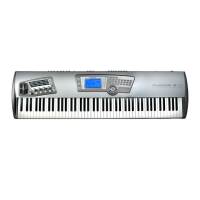3
Chapter 3: Fusion Modes
54
Menu: Program/Synth/Osc/Select
Parameter: EDIT Osc:
Value Range: Osc 1 to Osc 64
Select the oscillator you’d like to edit. The value in the parenthesis varies
depending on what note the oscillator has been assigned to (using the
“Note” parameter—see below).
Menu: Program/Synth/Osc/Select
Parameter: Enable
Value Range: On, Off
Allows you to enable or disable each oscillator.
Menu: Program/Synth/Osc/Select
Parameter: Note
Value Range: C-2 to G8
This parameter selects the note your oscillator will play on. Keep in
mind that it is possible for multiple oscillators to be assigned to the same
note.
Menu: Program/Synth/Osc/Select
Parameter: Start
Value Range: 0 % to 10%
When you set a Start point, you indicate how much of the initial attack
of your sample you want to include. When set to “0%,” the sample will
begin playing at the beginning. At “10%,” the sample will begin playing
10% into the sample and will bypass much of the natural “attack” of
your sample. Bypassing the attack of your sample results in more
“mellow” tone since much of the initial transient has been removed.
Sound designers sometimes use this parameter to control the perceived
“hardness” of the sound. For example, by mapping note velocity of the
keyboard to the start point of drum samples, the harder you strike the
keyboard, the more of the natural attack comes through resulting in a
seemingly “harder” strike (or pick, in the case of a guitar). Conversely, as
you play more softly, more of the attack is bypassed and a mellower tone
results.
About Zero-Crossings:
If you place your start point on a non-zero
crossing (i.e., at the top or the bottom of a
waveform) then you may hear a click or a
pop as the sample is triggered. This click
has nothing to do with the actual sample
attack, but can be perceived as an attack. If
you do not want this sound to appear in your
sample, you can either change the start point
until it lands on (or close to) a zero-
crossing, or you can set an amplitude
envelope attack time to about 5 or 10
milliseconds and that should smooth out any
clicks or pops.

